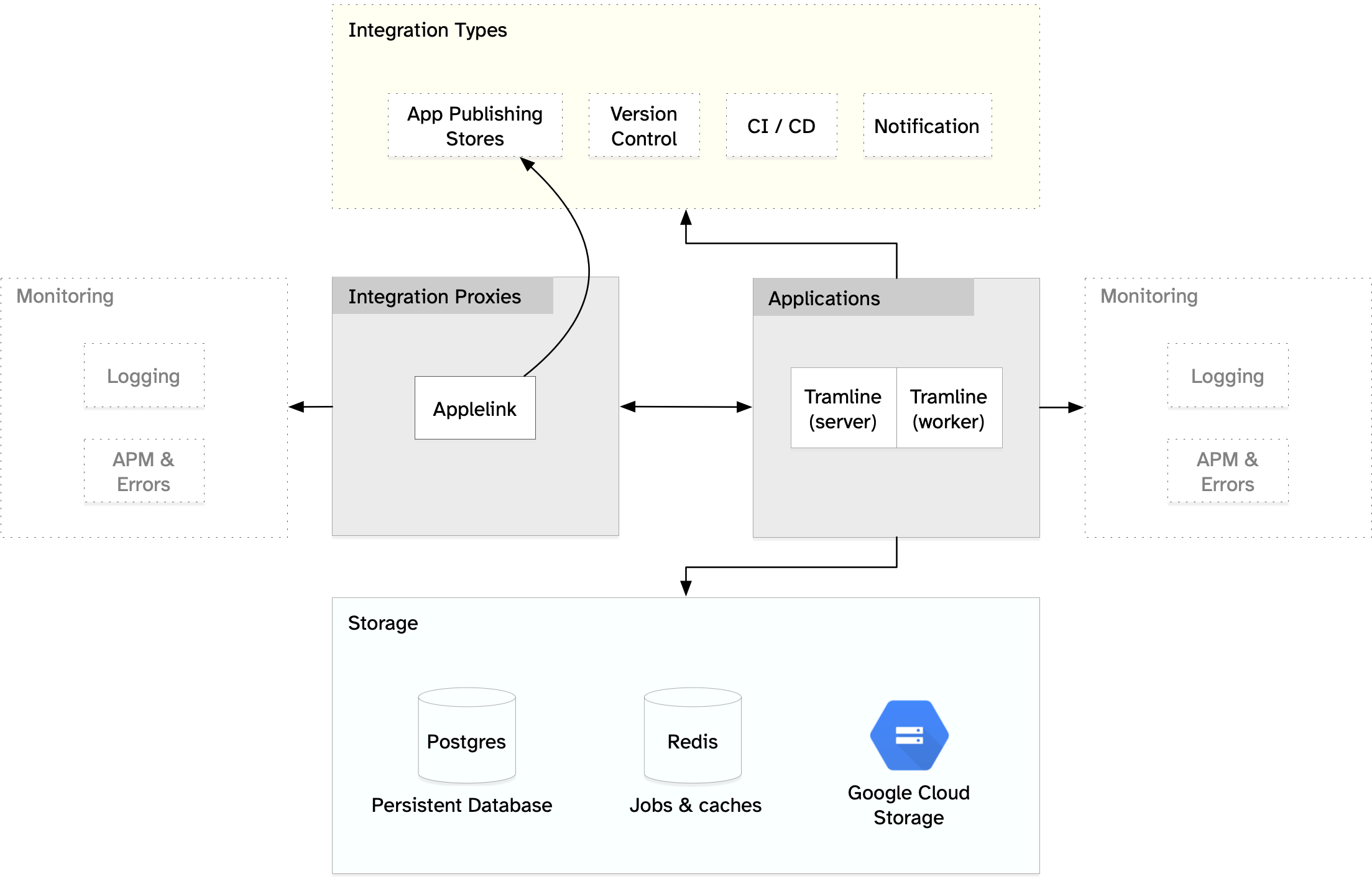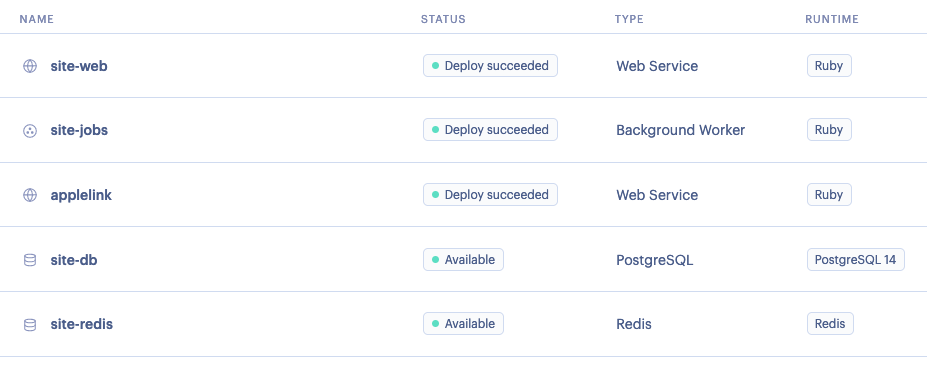
Release apps without drowning in process
Codify your app's release cycle,
deploy builds with increased confidence,
and give visibility to the entire organization.
Website · Latest Updates · Blog
A centralized dashboard to monitor and control all your mobile releases, that gives visibility into the release process to all stakeholders.
Using the release train model, you can setup different types of releases as separate trains comprising of different steps. For e.g. your production release train can look completely different from the release train that does frequent internal deploys.
Connect with all the essential tools you use during your release cycle: version control, notifications, CI/CD (build) servers, distribution services, and both App Store and Play Store.
Save time and reduce human error across the board by automating release-specific chores. For e.g.
- Create a new release branch for every release
- Create and merge release-specific branches, as determined by your branching strategy
- Submit build to the Store only after explicit approval
- Tag the final release build commit
- Don't allow starting a new release unless previous release-specific commits have landed in the working branch
Track and visualize release-specific metadata that you need to make informed decisions: release frequency, build times, review times, etc.
These steps assume setting it up on Render only. However, the instructions are standard enough to be adapted for a Heroku deployment or even bare-metal. A Dockerized setup is in the works and will come shortly.
Note
Since Render does not offer background workers under the free plan, you will have to put in your payment details to fully complete this deployment.
At minimum, you'll need the following to get Tramline up and running:
- This repository set up as the primary monolithic backend
- This repository set up as a background worker
- Postgres database
- Redis, preferably persistent
You'll also need to set up integrations for Tramline to be useful:
The guides above should help you setup the OAuth apps as necessary. They may ask you to fill up a redirect URL, this URL should be updated with the final DNS after everything is setup towards the end.
We need to setup GCP for storing builds in Tramline. After creating your service account as mentioned above, please create a GCS bucket named artifact-builds-prod to host your builds.
The deployment architecture looks like this:
To begin, first clone this repo. This ensures everything that you do is fully under your control.
In case you'd like to run this locally first, please follow the local development instructions.
To host Tramline directly, you'll need to prep your fork:
bin/setup.macbin/setup.creds -e prodKeep the production.key file safe and don't commit it!
After adding the encryption credentials, fill in the following details for the integrations in production.yml.enc by running bin/rails credentials:edit --environment production.
Follow the links mentioned earlier to setup the bare-minimum integrations.
For applelink, choose any string as your secret. We will use this later.
Use the following template:
active_record_encryption:
primary_key:
deterministic_key:
key_derivation_salt:
secret_key_base:
dependencies:
postmark:
api_token:
gcp:
project_id:
private_key_id:
private_key: |
client_email:
client_id:
client_x509_cert_url:
integrations:
slack:
app_id:
client_id:
client_secret:
signing_secret:
verification_token:
scopes: "app_mentions:read,channels:join,channels:manage,channels:read,chat:write,chat:write.public,files:write,groups:read,groups:write,im:read,im:write,usergroups:read,users.profile:read,users:read,users:read.email,commands,usergroups:write"
applelink:
iss: "tramline"
aud: "applelink"
secret: "any password"
github:
app_name:
app_id:
private_pem: |Save the credentials file and commit your changes. Use this button from your fork to kick-off a Render deployment.
The blueprint will ask for the RAILS_MASTER_KEY. Use the contents of production.key from the previous step.
If you would like to use the App Store integration, you'd have to configure the applelink service. You can skip this section otherwise.
- To start off, in your fork, uncomment the
applelinksection from therender.yamlfile. - Secondly, to your encryption file, add this to the integrations section, by running
bin/rails credentials:edit --environment production. Choose a secret key for authorization.
integrations:
applelink:
iss: "tramline.dev"
aud: "applelink"
secret: "any password"- Commit your changes and resync the blueprint on Render. This will kick-off the
applelinkservice. This will most likely fail to deploy on the first attempt, because it requires certain environment configuration. To do that, create aSecret Fileunderapplelink > Settings > Environment > Secret Filescalled.envand update with the following details by putting the applelink secret from the previous step underAUTH_SECRET:
RACK_ENV=production
WEB_CONCURRENCY=2
MAX_THREADS=1
PORT=3001
AUTH_ISSUER="tramline"
AUTH_AUD="applelink"
AUTH_SECRET=""
SENTRY_DSN=""
Before we wrap up, we need to fix a couple of ENV variables:
- If you have setup applelink in the previous step, you must add an
APPLELINK_URLtosite-webwith the final DNS of theapplelinkservice. - The
HOSTNAMEinsite-webandsite-jobsmust be updated to point to the DNS ofsite-web(without the protocol).
Once all services on Render are green, your setup should look like this:
That should be it! You can use the default DNS from site-web to launch Tramline. You can configure and tweak more settings later.
First copy the sample env file,
cp .env.development.sample .env.development.env.development is gitignored, so changes will remain local.
For local development, clone this repository and install the following pre-requisites:
docker
Follow the instructions here to install docker on your machine if you don't have it already. We recommend using Podman or OrbStack for managing containers locally.
ngrok
Setup an account (free or otherwise) here. ngrok is required for using webhooks from our third-party integrations like GitHub, GitLab, Bitbucket, etc. Follow the instructions here to install ngrok on your machine if you don't have it already. Add your token in .env.development under NGROK_AUTHTOKEN.
justfile
There's a Justfile that you can use to run common commands including starting the development environment, running specs, linting, etc.
Install just by following the instructions here.
secret credentials
If you're a trusted contributor, reach out to the existing developers for access to the dev master.key. Place the master.key file in the config directory or set RAILS_MASTER_KEY in .env.development.
If you're a new external contributor, run the following to setup your own credentials:
just pre-setupThis will setup the rails credentials via an interactive script. Once this is done, you should be able to boot up the application.
Note
Booting is insufficient to make Tramline entirely useful for dev. To run a proper release flow, you'd have to setup some basic integrations as well. See here.
You can start your local development environment by running the following command:
docker compose up
Refer to db/seeds.rb for credentials on how to login using the seed users.
Below are some common commands you can use via just:
just start– Starts the development environmentjust spec– Runs the specsjust lint– Runs the linterjust rails command– Runs a Rails command in the web containerjust rake command– Runs a Rake command in the web containerjust bundle command– Runs a Bundler command in the web containerjust devlog– Tails the development logjust bglog– Tails the background worker logjust shell– Opens a shell in any docker container
In case the above list is stale, run just --summary to see the full list.
Tramline is an integration-heavy service. It doesn't do much without some basic integration setup. Even though we connect to a lot of third-party services, for a basic development setup, only GitHub is truly necessary. So to setup an integration with GitHub, you must create an OAuth GitHub app first. And then run the following:
just rails credentials:editFill the following content/section in the credentials file:
integrations:
github:
app_name:
app_id:
private_pem: |Tip
After saving credentials, restart the web service to take effect.
Webhooks need access to the application over the Internet and that requires tunneling on the localhost environment. We use ngrok and it is started in the local development environment using Docker Compose.
- Use
just bundle add <gem>to add a new gem. - To update a gem use
just bundle update <gem>.
Tip
You might need to restart the web, sidekiq and/or css containers after adding or updating a gem.
Using the just bundle add tool auto-applies
the pessimistic operator in the Gemfile.
Although Gemfile.lock is the correct source of gem versions, specifying the pessimistic operator makes for a simpler
and safer update path through bundler for future users.
Doing this for development/test groups is optional.
You can attach to a running container using the just attach <service-name> command.
Once attached, any pry session will be available in the container. To detach, press ctrl-d.
Warning
Killing the attached container will kill the container process. Ensure you use the right escape sequence for detaching.
The default service name is web, so you can use just attach to attach to the web container.
We use SSL locally and certificates are also generated as part of the setup script. It's recommended to use https://tramline.local.gd:3000.
This is the default HOST_NAME that can be changed via .env.development if necessary.
All e-mails are caught and can be viewed here.
The dashboard for all background jobs can be viewed here.
All feature-flags are managed through flipper. The UI can be viewed here.
We are still in the early stages and would <3 any feedback you have to offer. You can get in touch with us in several ways:
- Join our Discord server to ask us questions or share your thoughts
- Submit a feature request or bug report
- Open a pull request (see instructions for local setup here)







